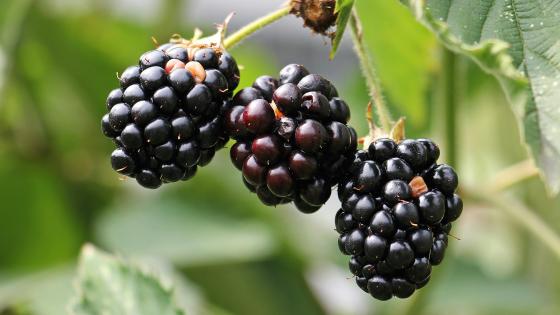
Blackberries
Blackberries
Blackberries (Rubus spp.) are included in the group of small fruits generally referred to as 'brambles' or 'caneberries.' They have perennial crowns and roots. Most blackberry types produce canes the first season (primocanes0 that do not bear fruit. They following year these are called floricanes, and bear fruit and then die naturally after harvest. Primocane-fruiting blackberries are an exception. They produce fruit on the primocanes in late summer and fall and again on these same canes (floricanes) the following July and early August before dying. With favorable growing conditions, brambles may produce for 12 or more years. Blackberries are grouped according to their growth habit: erect, semi-erect or trailing. Erect (thorny and thornless) and semi-erect (thornless) blackberries grow and yield well in most parts of the state. The trailing types are not recommended for commercial production in Kentucky due to their lack of winter hardiness. Primocane-fruiting thorny and thornless blackberries also do well in Kentucky; however, hot summers substantially reduce the primocane crop because a week of temperatures above 85 degrees F causes flowers to abort.
Key Requirements
| Land | Low to Medium |
| Labor | High |
| Capital | Medium |
Take the HortBizQuiz to see how much Land, Labor, and Capital you have for your operation.
Markets
- Direct to Consumer
- Farmer's Market
- On-Farm Stands
- CSA
- U-Pick
- Local Grocery
- Auctions
Pests & Disease
Common disease problems include anthracnose, crown gall, orange rust, rosette, fruit rots, and several viruses. Mites, cane and crown borers, aphids, green June beetles, and Japanese beetles also damage blackberries.
Costs and returns are presented as estimates. They will vary based on your farm and markets and blackberry type.
Costs and returns are presented as estimates. They will vary based on your farm and markets and blackberry type.
Challenges
- Blackberries do not store or ship well which limits market radius.
- High maintenance crop requiring spring pruning and training as well as the removal of dead fruiting canes from the previous season.
- Significant startup cost with more than two years after establishment before a full blackberry crop can be sold.
Opportunities
- Growers located near population centers might have a marketing edge due to the demand for local produce.
- Potential to supply fruit to jam producers or manufacturing your own value-added products.